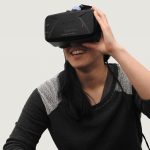Virtual reality is the next big thing in travel and tourism. The tourism and VR industries are a match made in heaven.
How so?
VR is rapidly changing the entire sphere of travel and tourism in and around the world. In 2018, the market size of the AR and VR market was around $18 billion. This is set to rise to a whopping $209 billion by 2022.
It doesn’t matter what aspect of the travel industry you are present in. If you are someone working in the travel industry, then VR may be the next big thing for you.
So, let’s figure out how VR can actually help you with your travel business.
Why Should You Use Virtual Reality in Tourism?
For instance, you are a travel company. Now, instead of selling the destinations through word of mouth, or pictures and videos on your website, you can actually let your consumer feel how the place is like.
Just with the help of a small setup and a pair of VR glasses you can make the selling experience incomparably more immersive for the potential consumers. Now, doesn’t that sound like something worth looking into?
Moreover, travel companies can win the trust of their potential consumers by giving them a VR tour of the accommodation, the hotel room, and all the interesting places around the destination. In simpler terms, a company can use virtual reality in tourism as another tool for digital marketing rather than completely replacing the physical tourism aspect.
For example, in 2018 the Japan-based First Airlines started offering the customers the ability to fly to a number of destinations in a mock aircraft just by using VR. This experience seemed likely to be used by someone who has a fear of flying and how it really feels to fly.
Difference Between VR and Social VR | Virtual Reality in Tourism
While Virtual reality is something that we all are aware of by now, Social VR or multi-user VR is the gold. Let’s learn about the same in a simpler manner.
VR provides the user with a completely different environment and an immersive experience. Social VR, or multi-user VR, adds a personal touch into the experience. In 2014, when Facebook bought Oculus, Mark Zuckerberg had already visualised the future of VR. He defined how a user will be able to live the memories shared by their friends through a 360 video rather than just a notification popping up on their profiles.
So, you get the difference by now. Social VR is the future with more than 172 million users worldwide already.
7 Uses of Virtual Reality in Tourism
Sell A Location Remotely
You can sell a location directly from your office, without having to fly anyone in. For instance, if you’re an event organiser and a client reaches out to you regarding a conference they want to host in your center and in your city. Now, instead of travelling to the location straightaway, you can just make them wear a VR headset and guide them through the venue through pre-selected 360 videos representing the space and showcasing the feeling of actually being there.
While the client goes through the venue, you can be a virtual guide to them from within the app and make sure that each and every query has been solved.
Showcase Experiences at Trade Shows
When you are at a trade show, you have a chance to showcase your talents to hundreds of prospect consumers. This is an opportunity you’d never want to miss. Instead of pitching the same script to each and every consumer why not pitch them the product, experience or destination itself?
Try selling the experience of your resort, location, conference centre or holiday destination with the help of VR. Make sure that your prospect consumer turns into a regular customer just with a small investment. Learn more about how to use Multi-User VR in this in-depth article.
Beautiful and Pleasant All Year Round
This can work out to be a good technique. Make sure that you have a 360-degree video made for each and every destination. This can help you to sell the dream destination to your customers even in an unfavourable season.
We at Hoppin’ World make sure that we capture each and every destination in the season which brings the most out of that place. This ensures that we have an increased saleability factor each time a consumer is thinking about visiting a place.
Don’t Just Sell The Product
Selling is all about providing more value to your consumer than they’re actually paying for. Virtual reality can ensure that. While you’re selling something to your prospect consumer make sure they don’t just buy it for the sake of the product but everything else they get with it.
For instance, you’re a real estate company and are looking for buyers for your new project. Now, instead of just showing them the property, let your consumers know there’s more to it, by showing them the neighborhood around the property and having them feel it in the most beautiful month of the year.
You can demonstrate the beautiful surroundings in the proximity, the lifestyle of the people, and much more. Make sure you give them the complete value for their money using VR.
Show Exactly What You Want To
With virtual reality and social VR, you control the experience while giving your potential customers the feeling that they control the experience. You can ensure that the locations you are marketing to your end consumer involve only the best.
Using VR you can ensure that the consumer is getting the smoothest and the best immersive experience of the place.
Immortalize Your Brand’s Presence
Once you’ve put something up on the internet, it’s going to stay there. That’s the beauty of it. You can use virtual reality to immortalize your brand in a similar manner. By making a one-time investment in virtual reality you can make sure that your content is there to stay.
Using Hoppin’s services you can ensure that the presence of your brand stays for a longer time. For instance, let’s say Heineken sponsors a major music festival. Now, by using Hoopin’s innovative VR technology and craftsmanship, the brand can ensure that the content gets immortalized by uploading that on Hoppin’s app. This makes the investment much more worthwhile does it not?
Connect With Millennials & Gen Z
Yes, millennials. The younger generations are all about ‘experiences’ rather than a product or service.
With using virtual reality you’re creating an unprecedented amount of goodwill for your brand. The use of VR in your marketing and selling strategy portrays that the company values engagement, interaction and is keeping up with the times.
In a trade show or in any other conference, a VR setup with some gizmos is going to attract a lot of people from the younger generation who’d want to explore how your company is making use of virtual reality. For instance, if you are a travel firm who is marketing their upcoming trip to an exotic island. Now, for a millennial, the thing that’s going to matter the most is the experience. Make them go through a demo version of what they should expect there. This way, you haven’t just gotten a potential client but also have a huge amount of PR through word of mouth.
Conclusion | Virtual Reality in Tourism Will Boom
According to a study by Capgemini, 82 % of the companies which implemented AR/VR in their operations indicated that the benefits usually exceeded expectations. The people who have invested in VR have reported better productivity, efficiency and safety.
Don’t want to get left behind? Here’s where Hoppin comes in. With our advanced technology and all-inclusive consulting services we’ll make sure that your brand gets the best out of your VR investment. Our solution is simple and cost effective. Click here for a free consultation with our experts.
Until Next Time,
The Hoppin’ Team






